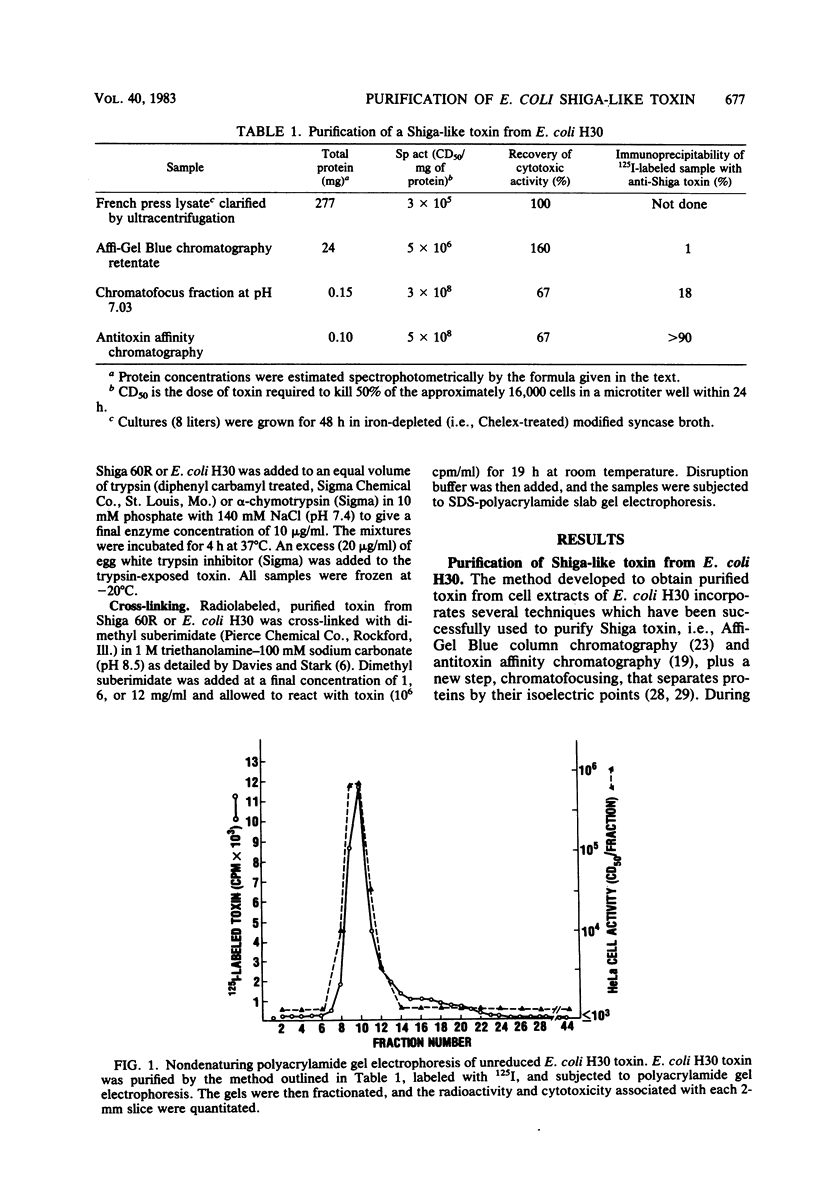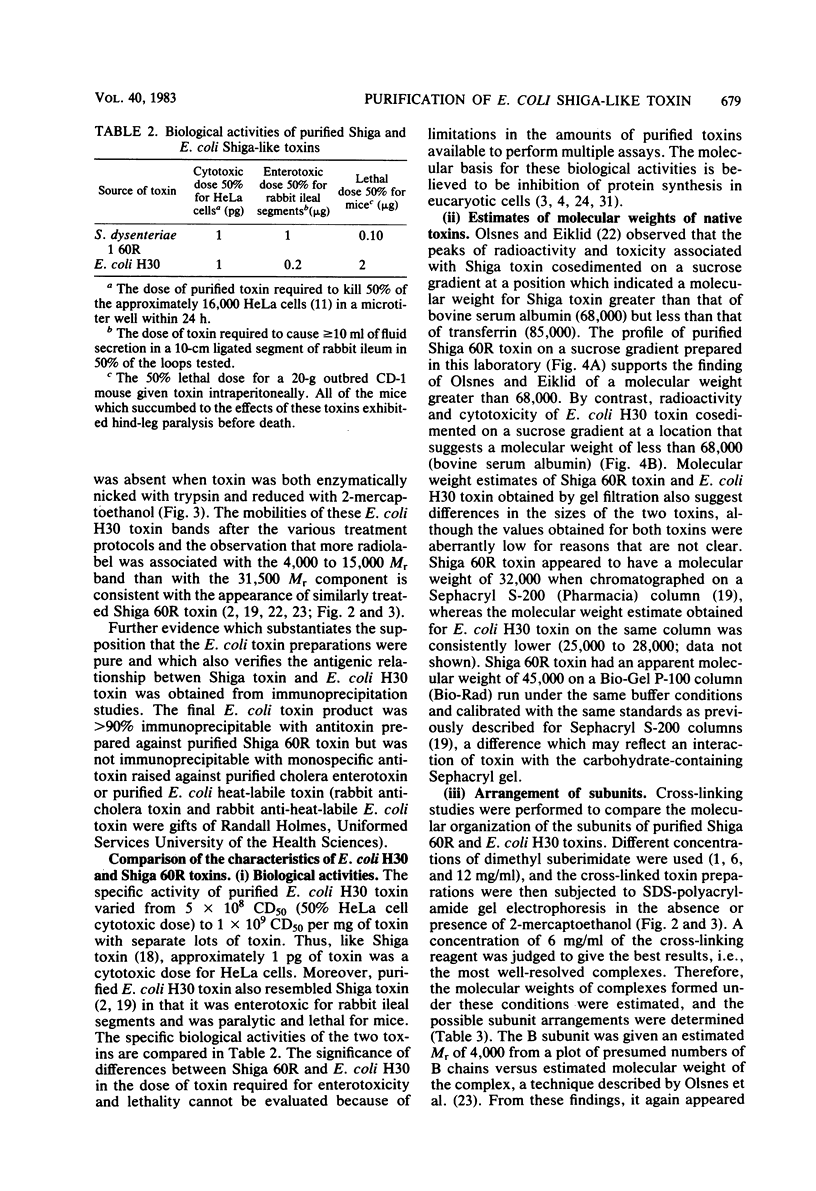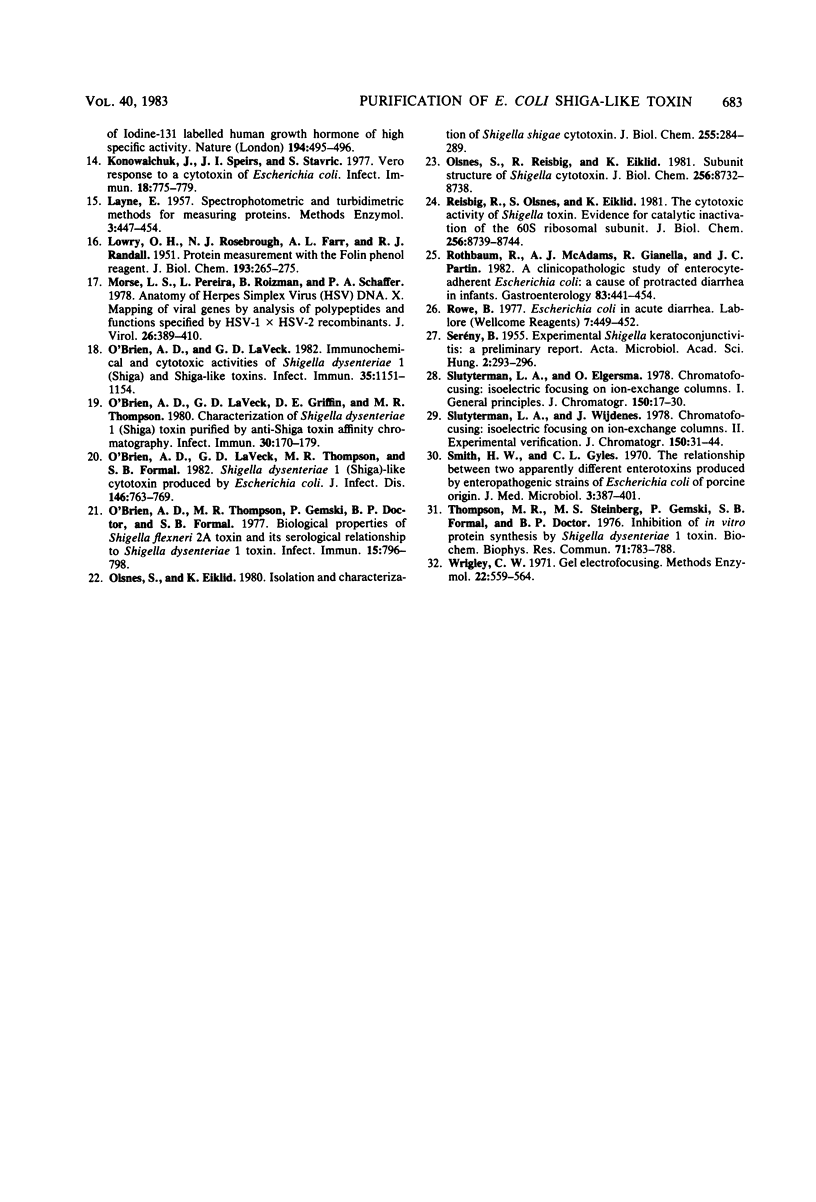Abstract
A toxin from an enteropathogenic strain of Escherichia coli (E. coli H30) was purified to apparent homogeneity from cell lysates. The steps used to isolate the E. coli H30 toxin included French pressure-cell disruption of bacteria grown in iron-depleted media. Affi-Gel Blue chromatography, chromatofocusing, and anti-Shiga toxin affinity chromatography. The mobilities of the subunits of radioiodinated E. coli H30 toxin and Shiga toxin observed after the two toxins were subjected to sodium dodecyl sulfate-polyacrylamide gel electrophoresis were identical. In the absence of 2-mercaptoethanol, a narrow band was seen at Mr 31,500 (+/- 1,000), and a wide heavy band was observed between Mr 4,000 and 15,000. In the presence of 2-mercaptoethanol, bands were seen at Mr 31,500 (+/- 1,000), 27,000, and 4,000 to 15,000. Other similarities between purified E. coli H30 and Shiga 60R toxins included identical isoelectric points (7.03 +/- 0.02); comparable biological activities, i.e., cytotoxicity, lethality for mice, and enterotoxicity; and the same relative heat stabilities (up to 65 degrees C for 30 min). Nevertheless, the two toxins had apparently different molecular weights as determined by sucrose gradient analysis, by gel filtration, and by cross-linking experiments with dimethyl suberimidate. The Mr of native E. coli H30 toxin estimated from cross-linking studies was 48,000, whereas the estimated Mr of Shiga 60R toxin was 58,000. These results suggest that like the cholera-E. coli-heat-labile toxin family, a family of Shiga-like toxins exists.
Full text
PDF








Images in this article
Selected References
These references are in PubMed. This may not be the complete list of references from this article.
- Brown J. E., Griffin D. E., Rothman S. W., Doctor B. P. Purification and biological characterization of shiga toxin from Shigella dysenteriae 1. Infect Immun. 1982 Jun;36(3):996–1005. doi: 10.1128/iai.36.3.996-1005.1982. [DOI] [PMC free article] [PubMed] [Google Scholar]
- Brown J. E., Rothman S. W., Doctor B. P. Inhibition of protein synthesis in intact HeLa cells by Shigella dysenteriae 1 toxin. Infect Immun. 1980 Jul;29(1):98–107. doi: 10.1128/iai.29.1.98-107.1980. [DOI] [PMC free article] [PubMed] [Google Scholar]
- Brown J. E., Ussery M. A., Leppla S. H., Rothman S. W. Inhibition of protein synthesis by Shiga toxin: activation of the toxin and inhibition of peptide elongation. FEBS Lett. 1980 Aug 11;117(1):84–88. doi: 10.1016/0014-5793(80)80918-5. [DOI] [PubMed] [Google Scholar]
- Clausen C. R., Christie D. L. Chronic diarrhea in infants caused by adherent enteropathogenic Escherichia coli. J Pediatr. 1982 Mar;100(3):358–361. doi: 10.1016/s0022-3476(82)80429-0. [DOI] [PubMed] [Google Scholar]
- Davies G. E., Stark G. R. Use of dimethyl suberimidate, a cross-linking reagent, in studying the subunit structure of oligomeric proteins. Proc Natl Acad Sci U S A. 1970 Jul;66(3):651–656. doi: 10.1073/pnas.66.3.651. [DOI] [PMC free article] [PubMed] [Google Scholar]
- FORMAL S. B., KUNDEL D., SCHNEIDER H., KUNEVN, SPRINZ H. Studies with Vibrio cholerae in the ligated loop of the rabbit intestine. Br J Exp Pathol. 1961 Oct;42:504–510. [PMC free article] [PubMed] [Google Scholar]
- Formal S. B., O'Brien A., Gemski P., Doctor B. P. Invasive Escherichia coli. J Am Vet Med Assoc. 1978 Sep 1;173(5 Pt 2):596–598. [PubMed] [Google Scholar]
- Gentry M. K., Dalrymple J. M. Quantitative microtiter cytotoxicity assay for Shigella toxin. J Clin Microbiol. 1980 Sep;12(3):361–366. doi: 10.1128/jcm.12.3.361-366.1980. [DOI] [PMC free article] [PubMed] [Google Scholar]
- Gurwith M. J., Wiseman D. A., Chow P. Clinical and laboratory assessment of the pathogenicity of serotyped enteropathogenic Escherichia coli. J Infect Dis. 1977 May;135(5):735–743. [PubMed] [Google Scholar]
- HUNTER W. M., GREENWOOD F. C. Preparation of iodine-131 labelled human growth hormone of high specific activity. Nature. 1962 May 5;194:495–496. doi: 10.1038/194495a0. [DOI] [PubMed] [Google Scholar]
- Konowalchuk J., Speirs J. I., Stavric S. Vero response to a cytotoxin of Escherichia coli. Infect Immun. 1977 Dec;18(3):775–779. doi: 10.1128/iai.18.3.775-779.1977. [DOI] [PMC free article] [PubMed] [Google Scholar]
- LOWRY O. H., ROSEBROUGH N. J., FARR A. L., RANDALL R. J. Protein measurement with the Folin phenol reagent. J Biol Chem. 1951 Nov;193(1):265–275. [PubMed] [Google Scholar]
- Morse L. S., Pereira L., Roizman B., Schaffer P. A. Anatomy of herpes simplex virus (HSV) DNA. X. Mapping of viral genes by analysis of polypeptides and functions specified by HSV-1 X HSV-2 recombinants. J Virol. 1978 May;26(2):389–410. doi: 10.1128/jvi.26.2.389-410.1978. [DOI] [PMC free article] [PubMed] [Google Scholar]
- O'Brien A. D., LaVeck G. D., Griffin D. E., Thompson M. R. Characterization of Shigella dysenteriae 1 (Shiga) toxin purified by anti-Shiga toxin affinity chromatography. Infect Immun. 1980 Oct;30(1):170–179. doi: 10.1128/iai.30.1.170-179.1980. [DOI] [PMC free article] [PubMed] [Google Scholar]
- O'Brien A. D., LaVeck G. D., Thompson M. R., Formal S. B. Production of Shigella dysenteriae type 1-like cytotoxin by Escherichia coli. J Infect Dis. 1982 Dec;146(6):763–769. doi: 10.1093/infdis/146.6.763. [DOI] [PubMed] [Google Scholar]
- O'Brien A. D., Laveck G. D. Immunochemical and cytotoxic activities of Shigella dysenteriae 1 (shiga) and shiga-like toxins. Infect Immun. 1982 Mar;35(3):1151–1154. doi: 10.1128/iai.35.3.1151-1154.1982. [DOI] [PMC free article] [PubMed] [Google Scholar]
- O'Brien A. D., Thompson M. R., Gemski P., Doctor B. P., Formal S. B. Biological properties of Shigella flexneri 2A toxin and its serological relationship to Shigella dysenteriae 1 toxin. Infect Immun. 1977 Mar;15(3):796–798. doi: 10.1128/iai.15.3.796-798.1977. [DOI] [PMC free article] [PubMed] [Google Scholar]
- Olsnes S., Eiklid K. Isolation and characterization of Shigella shigae cytotoxin. J Biol Chem. 1980 Jan 10;255(1):284–289. [PubMed] [Google Scholar]
- Olsnes S., Reisbig R., Eiklid K. Subunit structure of Shigella cytotoxin. J Biol Chem. 1981 Aug 25;256(16):8732–8738. [PubMed] [Google Scholar]
- Reisbig R., Olsnes S., Eiklid K. The cytotoxic activity of Shigella toxin. Evidence for catalytic inactivation of the 60 S ribosomal subunit. J Biol Chem. 1981 Aug 25;256(16):8739–8744. [PubMed] [Google Scholar]
- Rothbaum R., McAdams A. J., Giannella R., Partin J. C. A clinicopathologic study of enterocyte-adherent Escherichia coli: a cause of protracted diarrhea in infants. Gastroenterology. 1982 Aug;83(2):441–454. [PubMed] [Google Scholar]
- SERENY B. Experimental shigella keratoconjunctivitis; a preliminary report. Acta Microbiol Acad Sci Hung. 1955;2(3):293–296. [PubMed] [Google Scholar]
- Smith H. W., Gyles C. L. The relationship between two apparently different enterotoxins produced by enteropathogenic strains of Escherichia coli of porcine origin. J Med Microbiol. 1970 Aug;3(3):387–401. doi: 10.1099/00222615-3-3-387. [DOI] [PubMed] [Google Scholar]
- Thompson M. R., Steinberg M. S., Gemski P., Formal S. B., Doctor B. P. Inhibition of in vitro protein synthesis by Shigella dysenteriae 1 toxin. Biochem Biophys Res Commun. 1976 Aug 9;71(3):783–788. doi: 10.1016/0006-291x(76)90899-8. [DOI] [PubMed] [Google Scholar]





